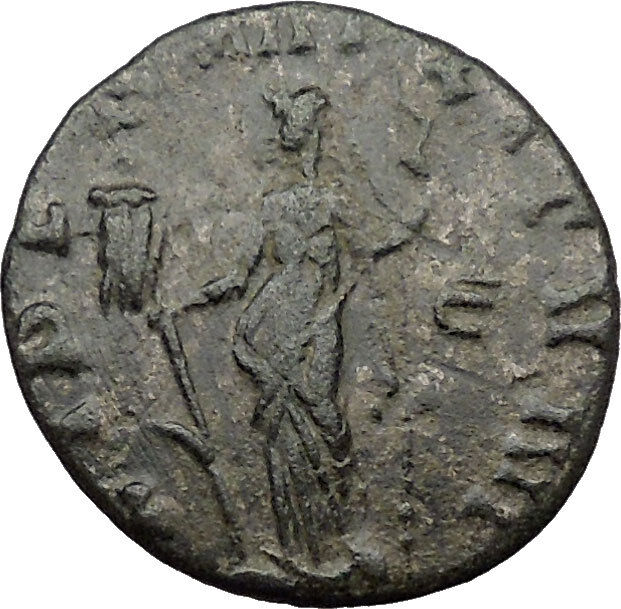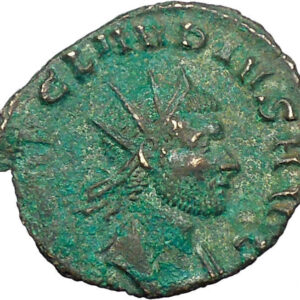|
Claudius II
Gothicus –
Roman Emperor
: 268-270 A.D.
Bronze Antoninianus 20mm (3.13 grams) Rome mint: 268 A.D.
Reference: RIC 36f, C 87
IMPCCLAVDIVSAVG – Radiate, cuirassed bust right.
FIDESEXERCI –
Fides
standing left, holding standard in either hand.
You are bidding on the exact item pictured,
provided with a Certificate of Authenticity and Lifetime Guarantee of
Authenticity.
Standards

Roman military standards. The standards with discs, or signa
(first three on left) belong to centuriae of the
legion (the image does not show the heads of the standards – whether
spear-head or wreathed-palm). Note (second from right) the
legion’s
aquila
. The standard on the
extreme right probably portrays the
She-wolf
(lupa) which fed
Romulus
, the legendary founder of
Rome. (This was the emblem of
Legio VI Ferrata
, a legion then
based in
Judaea
, a detachment of which is
known to have fought in Dacia). Detail from Trajan’s Column, Rome

Modern reenactors parade with replicas of various legionary
standards. From left to right: signum (spear-head type), with
four discs; signum (wreathed-palm type), with six discs;
imago of ruling emperor; legionary aquila; vexillum
of commander (legatus) of
Legio XXX Ulpia Victrix
, with
embroidered name and emblem (Capricorn) of legion
Each tactical unit in the imperial army, from centuria upwards, had
its own standard. This consisted of a pole with a variety of adornments that was
borne by dedicated standard-bearers who normally held the rank of duplicarius.
Military standards had the practical use of communicating to unit members where
the main body of the unit was situated, so that they would not be separated, in
the same way that modern tour-group guides use umbrellas or flags. But military
standards were also invested with a mystical quality, representing the divine
spirit (genius) of the unit and were revered as such (soldiers frequently
prayed before their standards). The loss of a unit’s standard to the enemy was
considered a terrible stain on the unit’s honour, which could only be fully
expunged by its recovery.
The standard of a centuria was known as a signum, which was
borne by the unit’s signifer. It consisted of a pole topped by either an
open palm of a human hand or by a spear-head. The open palm, it has been
suggested, originated as a symbol of the
maniple
(manipulus = “handful”), the
smallest tactical unit in the
Roman army of the mid-Republic
. The poles were
adorned with two to six silver discs (the significance of which is uncertain).
In addition, the pole would be adorned by a variety of cross-pieces (including,
at bottom, a crescent-moon symbol and a tassel). The standard would also
normally sport a cross-bar with tassels.
The standard of a Praetorian cohort or an auxiliary cohort or ala was
known as a vexillum
or banner. This was a square flag,
normally red in colour, hanging from a crossbar on the top of the pole. Stitched
on the flag would be the name of the unit and/or an image of a god. An exemplar
found in Egypt bears an image of the goddess Victory on a red background. The
vexillum was borne by a vexillarius. A legionary detachment (vexillatio)
would also have its own vexillum. Finally, a vexillum
traditionally marked the commander’s position on the battlefield.[194]
The exception to the red colour appears to have been the Praetorian Guard, whose
vexilla, similar to their clothing, favoured a blue background.
From the time of
Marius
(consul 107 BC), the standard of all
legions was the
aquila
(“eagle”). The pole was surmounted
by a sculpted eagle of solid gold, or at least gold-plated silver, carrying
thunderbolts in its claws (representing
Jupiter
, the highest Roman god. Otherwise the
pole was unadorned. No exemplar of a legionary eagle has ever been found
(doubtless because any found in later centuries were melted down for their gold
content). The eagle was borne by the aquilifer, the legion’s most senior
standard-bearer. So important were legionary eagles as symbols of Roman military
prestige and power, that the imperial government would go to extraordinary
lengths to recover those captured by the enemy. This would include launching
full-scale invasions of the enemy’s territory, sometimes decades after the
eagles had been lost e.g. the expedition in 28 BC by
Marcus Licinius Crassus
against
Genucla
(Isaccea, near modern
Tulcea
, Rom., in the Danube delta region), a
fortress of the Getae
, to recover standards lost 33 years
earlier by
Gaius Antonius
, an earlier
proconsul
of
Macedonia
. Or the campaigns of AD 14-17 to
recover the three eagles lost by
Varus
in AD 6 in the
Teutoburg Forest
.
Under Augustus, it became the practice for legions to carry portraits (imagines)
of the ruling emperor and his immediate family members. An imago was
usually a bronze bust carried on top of a pole like a standard by an
imaginifer.
From around the time of Hadrian (r. 117-38), some auxiliary alae
adopted the dragon-standard (draco) commonly carried by Sarmatian cavalry
squadrons. This was a long cloth wind-sock attached to an ornate sculpture of an
open dragon’s mouth. When the bearer (draconarius) was galloping, it
would make a strong hissing-sound.
Decorations
The Roman army awarded a variety of individual decorations (dona) for
valour to its legionaries. Hasta pura was a miniature spear; phalerae
were large medal-like bronze or silver discs worn on the cuirass; armillae
were bracelets worn on the wrist; and
torques were worn round the neck, or on the cuirass. The highest
awards were the coronae (“crowns”), of which the most prestigious was the
corona civica, a crown made oak-leaves awarded for saving the life of a
fellow Roman citizen in battle. The most valuable award was the corona
muralis, a crown made of gold awarded to the first man to scale an enemy
rampart. This was awarded rarely, as such a man hardly ever survived.
There is no evidence that auxiliary common soldiers received individual
decorations like legionaries, although auxiliary officers did. Instead, the
whole regiment was honoured by a title reflecting the type of award e.g.
torquata (“awarded a torque”) or armillata (“awarded bracelets”).
Some regiments would, in the course of time, accumulate a long list of titles
and decorations e.g. cohors I Brittonum Ulpia torquata pia fidelis c.R..
In
Roman mythology
, Fides (“trust”) was the goddess of
trust
. Her Greek
equivalent was
Pistis
. Her temple on the
Capitol was where
the Roman Senate
kept state treaties with foreign countries, where Fides
protected them. She was also worshipped under the name Fides Publica Populi
Romani (“trust towards the Roman state”). She is represented by a young
woman crowned with an olive branch, with a cup or
turtle
, or a
military ensign in hand. She wears a white veil or stola; her priests wear
white.
Rome’s second king,
Numa Pompilius
instituted a yearly festival to Fides, and directed the priests to be borne to
Her temple in an arched chariot drawn by two horses and should conduct Her
services with their hands wrapped up to indicate protection.
Marcus Aurelius Claudius (May
10, 213
– January, 270), often referred to as Claudius Gothicus or Claudius II,
was a Roman Emperor
. He ruled the
Roman
Empire
for less than two years (268 – 270), but during that brief time he
managed to obtain some successes. He was later given divine status.
//
Life
Origin
and rise to power
Claudius’ origin is uncertain. He was either from
Sirmium
(Syrmia;
in Pannonia
Inferior) or from Naissus
Dardania
(in
Moesia Superior
); both areas are located in
Serbia
.
Claudius was the commander of the Roman army that decisively defeated the
Goths
at the
Battle of Naissus
in September 268; in the same month, he attained the
throne, amid charges, never proven, that he murdered his predecessor
Gallienus
.
However, he soon proved to be less than bloodthirsty, as he asked the
Roman
Senate
to spare the lives of Gallienus’ family and supporters. He was less
magnanimous toward Rome’s enemies, however, and it was to this that he owed his
popularity.
Claudius, like
Maximinus Thrax
before him, was of barbarian birth. After an interlude of
failed aristocratic Roman emperors since Maximinus’s death, Claudius was the
first in a series of tough soldier-emperors who would eventually restore the
Empire from the
Crisis of the third century
.
Claudius
as emperor
At the time of his accession, the Roman Empire was in serious danger from
several incursions, both within and outside its borders. The most pressing of
these was an invasion of Illyricum and
Pannonia
by
the Goths
. Not
long after being named emperor (or just prior to Gallienus’ death, depending on
the source), he won his greatest victory, and one of the greatest in the history
of Roman arms.

The Roman Empire in 268 A.D
At the
Battle of Naissus
, Claudius and his legions routed a huge Gothic army.
Together with his cavalry commander, the future Emperor
Aurelian
,
the Romans took thousands of prisoners, destroyed the Gothic cavalry as a force
and stormed their laager (a circular alignment of wagons long favored by the
Goths). The victory earned Claudius his surname of “Gothicus” (conqueror of the
Goths), and that is how he is known to this day. More importantly, the Goths
were soon driven back across the
Danube River
, and a century passed before they again posed a serious threat
to the empire.
While this was going on, the Germanic tribe known as the
Alamanni
had crossed the Alps
and attacked the empire. Claudius responded quickly, routing the Alamanni at the
Battle of Lake Benacus
in the late fall of 268, a few months after the
battle of Naissus. He then turned on the
Gallic Empire
, ruled by a pretender for the past fifteen years and
encompassing
Britain
, Gaul
,
and the
Iberian Peninsula
. He won several victories and soon regained control of
Spain and the Rhone river valley of Gaul. This set the stage for the ultimate
destruction of the Gallic Empire under Aurelian.
However, Claudius did not live long enough to fulfill his goal of reuniting
all the lost territories of the empire. Late in 269 he was preparing to go to
war against the Vandals
, who were raiding in
Pannonia
.
However, he fell victim to the
Plague of Cyprian
(possibly
smallpox
),
and died early in January 270. Before his death, he is thought to have named
Aurelian as his successor, although Claudius’ brother
Quintillus
briefly seized power.
The Senate
immediately deified Claudius as “Divus Claudius Gothicus”.
Links
to
Constantinian dynasty
The
Historia Augusta
reports Claudius and Quintillus having another brother
named Crispus and through him a niece. Said niece Claudia reportedly married
Eutropius and was mother to
Constantius Chlorus
. Historians however suspect this account to be a
genealogical
fabrication intended to link
Constantine I
‘s family to that of a well-respected emperor.
|











